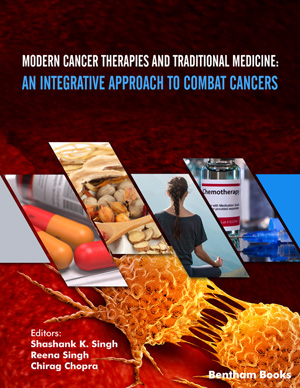
Abstract
Significant progress in anticancer research has led to a rise in the study of bioactive chemicals with potential anticancer effects. Still, many bioactive natural chemicals must be investigated to generate more effective anti-cancer therapeutics. There have been many attempts to treat cancer. Based on diverse research, this review summarizes many bioactive substances obtained from nature that can fight against different types of malignancies with minimal harm. Polyphenolic flavonoids, carotenoid (fucoxanthin), tannin, and other notable natural bioactive with anticancer potential were examined and reviewed systematically with an eye toward their significance in many types of cancer treatment. Throughout the text, it was concluded that natural bioactive play a very prominent role in combating different types of cancer, and the information related to the bioactive role in cancer treatment over the last 10 years was gathered from several research and review articles. The material kept in this paper can act as a template for future research in expressing the more beneficial role of other bioactive in acting as an adjuvant in chemotherapy practice for prevention and treatment of various cancer additionally with no or minimal adverse effects, which are prominent with the conventional drugs used for the treatment of cancer.
Keywords: Bioactive, Cancer, chemotherapy, anti-cancer, natural
Graphical Abstract
[http://dx.doi.org/10.1093/abbs/gmq129] [PMID: 21258076]
[http://dx.doi.org/10.3322/caac.21660] [PMID: 33538338]
[http://dx.doi.org/10.3892/ijo.2016.3769] [PMID: 27878253]
[http://dx.doi.org/10.1007/s00345-019-02984-4] [PMID: 31676912]
[http://dx.doi.org/10.3322/caac.21601] [PMID: 32133645]
[http://dx.doi.org/10.1186/s12967-020-02554-y] [PMID: 33046107]
[http://dx.doi.org/10.14740/wjon1279] [PMID: 32494314]
[http://dx.doi.org/10.1038/s41575-020-0310-z] [PMID: 32606456]
[http://dx.doi.org/10.5334/aogh.2419] [PMID: 30741509]
[http://dx.doi.org/10.3389/fmed.2021.738693] [PMID: 34631756]
[http://dx.doi.org/10.14740/wjon1166] [PMID: 30834048]
[http://dx.doi.org/10.22270/jddt.v11i2.4758]
[http://dx.doi.org/10.1016/S2213-8587(21)00027-9] [PMID: 33662333]
[http://dx.doi.org/10.1016/j.jff.2020.104149] [PMID: 32837538]
[http://dx.doi.org/10.1039/D1NA00475A]
[http://dx.doi.org/10.1097/HM9.0000000000000008]
[http://dx.doi.org/10.1002/ijch.201900050] [PMID: 31680702]
[http://dx.doi.org/10.1016/j.biopha.2019.108852] [PMID: 30999152]
[http://dx.doi.org/10.1038/s41573-020-00114-z] [PMID: 33510482]
[http://dx.doi.org/10.3390/molecules26133855] [PMID: 34202689]
[http://dx.doi.org/10.3390/ijms221910774] [PMID: 34639131]
[http://dx.doi.org/10.1007/s42250-020-00213-9]
[http://dx.doi.org/10.3844/ajptsp.2006.21.25]
[http://dx.doi.org/10.1038/s41598-021-86391-z] [PMID: 33782460]
[http://dx.doi.org/10.1186/s13568-017-0351-z] [PMID: 28255861]
[http://dx.doi.org/10.3389/fphar.2017.00383] [PMID: 28694778]
[http://dx.doi.org/10.1002/ptr.5751] [PMID: 28093828]
[http://dx.doi.org/10.1021/acs.jnatprod.9b01285] [PMID: 32162523]
[http://dx.doi.org/10.1016/j.fct.2019.111013] [PMID: 31794803]
[http://dx.doi.org/10.3390/nu13082733] [PMID: 34444893]
[http://dx.doi.org/10.1016/B978-0-444-63929-5.00010-3]
[http://dx.doi.org/10.1111/bph.13627] [PMID: 27646173]
[http://dx.doi.org/10.1016/j.bcp.2020.113890] [PMID: 32119837]
[http://dx.doi.org/10.1155/2019/6057837]
[http://dx.doi.org/10.3390/ijms22062828] [PMID: 33799504]
[http://dx.doi.org/10.1016/j.jff.2020.104213]
[PMID: 32405344]
[http://dx.doi.org/10.4155/ppa-2017-0030] [PMID: 29227203]
[http://dx.doi.org/10.1155/2021/9913179] [PMID: 34484407]
[PMID: 31156781]
[http://dx.doi.org/10.3390/nu10111756] [PMID: 30441769]
[http://dx.doi.org/10.1080/01635581.2017.1324994] [PMID: 28569556]
[http://dx.doi.org/10.1080/10408398.2021.1913091] [PMID: 33890518]
[http://dx.doi.org/10.1016/j.jff.2018.07.037]
[http://dx.doi.org/10.1080/01635581.2020.1803932] [PMID: 32762370]
[http://dx.doi.org/10.1016/j.jff.2017.01.022] [PMID: 32288791]
[http://dx.doi.org/10.1016/j.biopha.2020.111102] [PMID: 33338743]
[http://dx.doi.org/10.4236/ajps.2018.96091]
[PMID: 35177980]
[http://dx.doi.org/10.1002/ptr.6155] [PMID: 30039547]
[http://dx.doi.org/10.4196/kjpp.2017.21.2.205] [PMID: 28280414]
[http://dx.doi.org/10.1002/mc.22318] [PMID: 25968914]
[http://dx.doi.org/10.3892/or.2016.4786] [PMID: 27175602]
[http://dx.doi.org/10.1111/cpr.12296] [PMID: 27641938]
[http://dx.doi.org/10.1007/s11033-016-3942-x] [PMID: 26748999]
[http://dx.doi.org/10.1039/C6FO00551A] [PMID: 28277581]
[http://dx.doi.org/10.1016/j.biopha.2016.05.029] [PMID: 27470402]
[http://dx.doi.org/10.1016/j.acthis.2016.11.003] [PMID: 27887793]
[http://dx.doi.org/10.3892/mmr.2019.9850] [PMID: 30664221]
[http://dx.doi.org/10.2147/DDDT.S291865] [PMID: 33623367]
[http://dx.doi.org/10.1016/j.jnutbio.2016.03.011] [PMID: 27260467]
[http://dx.doi.org/10.18632/oncotarget.10130] [PMID: 28881718]
[http://dx.doi.org/10.1016/j.phymed.2016.09.011] [PMID: 27823633]
[http://dx.doi.org/10.18632/oncotarget.11122] [PMID: 27521217]
[http://dx.doi.org/10.1016/j.biopha.2018.07.106] [PMID: 30119227]
[http://dx.doi.org/10.1039/C5NR08966B] [PMID: 26875690]
[http://dx.doi.org/10.1016/j.jmst.2017.01.004]
[http://dx.doi.org/10.3390/molecules22081270] [PMID: 28758919]
[http://dx.doi.org/10.3390/cancers12082276] [PMID: 32823876]
[http://dx.doi.org/10.1080/01635581.2017.1367936] [PMID: 29083228]
[http://dx.doi.org/10.1007/s00210-018-1579-0] [PMID: 30465055]
[http://dx.doi.org/10.2174/1871527318666190314103104]
[http://dx.doi.org/10.3892/etm.2017.4494] [PMID: 28672902]
[http://dx.doi.org/10.11620/IJOB.2016.41.1.045]
[http://dx.doi.org/10.1016/j.arcmed.2018.09.008] [PMID: 30314650]
[http://dx.doi.org/10.1016/j.cbi.2015.06.011] [PMID: 26091902]
[http://dx.doi.org/10.1155/2019/6407210] [PMID: 31781632]
[http://dx.doi.org/10.1039/C6MB00161K] [PMID: 27035097]
[http://dx.doi.org/10.1007/s10876-020-01792-w]
[http://dx.doi.org/10.3390/ijms21239273] [PMID: 33291743]
[http://dx.doi.org/10.3390/md15020039] [PMID: 28212270]
[http://dx.doi.org/10.1016/j.btre.2018.e00296] [PMID: 30581767]
[http://dx.doi.org/10.3390/md17060338] [PMID: 31195739]
[http://dx.doi.org/10.3390/molecules26144288] [PMID: 34299562]
[http://dx.doi.org/10.1111/jcmm.14151] [PMID: 30648805]
[http://dx.doi.org/10.1002/jbt.22771] [PMID: 33720461]
[http://dx.doi.org/10.3390/nu12082430] [PMID: 32823596]
[http://dx.doi.org/10.1016/j.cbi.2017.07.009] [PMID: 28709945]
[http://dx.doi.org/10.1016/j.sjbs.2020.02.015] [PMID: 32256171]
[http://dx.doi.org/10.1080/10799893.2020.1719152] [PMID: 32024401]
[http://dx.doi.org/10.3389/fphar.2020.01021] [PMID: 33041781]
[http://dx.doi.org/10.3390/nu13020332] [PMID: 33498667]
[http://dx.doi.org/10.1016/j.phymed.2015.11.005] [PMID: 26902401]
[http://dx.doi.org/10.18632/oncotarget.12596] [PMID: 27738325]
[http://dx.doi.org/10.1039/C9BM01605H] [PMID: 31750450]
[http://dx.doi.org/10.3390/pharmaceutics12111107] [PMID: 33217989]
[http://dx.doi.org/10.1080/10408398.2021.1913092] [PMID: 33872094]
[http://dx.doi.org/10.3233/JBR-190429]
[http://dx.doi.org/10.1093/carcin/bgy009] [PMID: 29361151]
[http://dx.doi.org/10.1039/C9RA01772K] [PMID: 35515294]
[http://dx.doi.org/10.1039/C9FO01721F] [PMID: 31621765]
[http://dx.doi.org/10.1186/s12885-016-2465-0] [PMID: 27388461]
[http://dx.doi.org/10.1016/j.ijpharm.2020.119597] [PMID: 32629067]
[http://dx.doi.org/10.1038/s41598-020-68608-9] [PMID: 32724173]
[http://dx.doi.org/10.3390/jpm11080756] [PMID: 34442400]
[http://dx.doi.org/10.1186/1756-9966-29-12] [PMID: 20152024]
[http://dx.doi.org/10.2147/OTT.S247646] [PMID: 32368081]
[http://dx.doi.org/10.1093/carcin/24.3.555] [PMID: 12663518]
[http://dx.doi.org/10.1593/neo.04232] [PMID: 15548374]
[http://dx.doi.org/10.3390/ijms19010263] [PMID: 29337925]
























